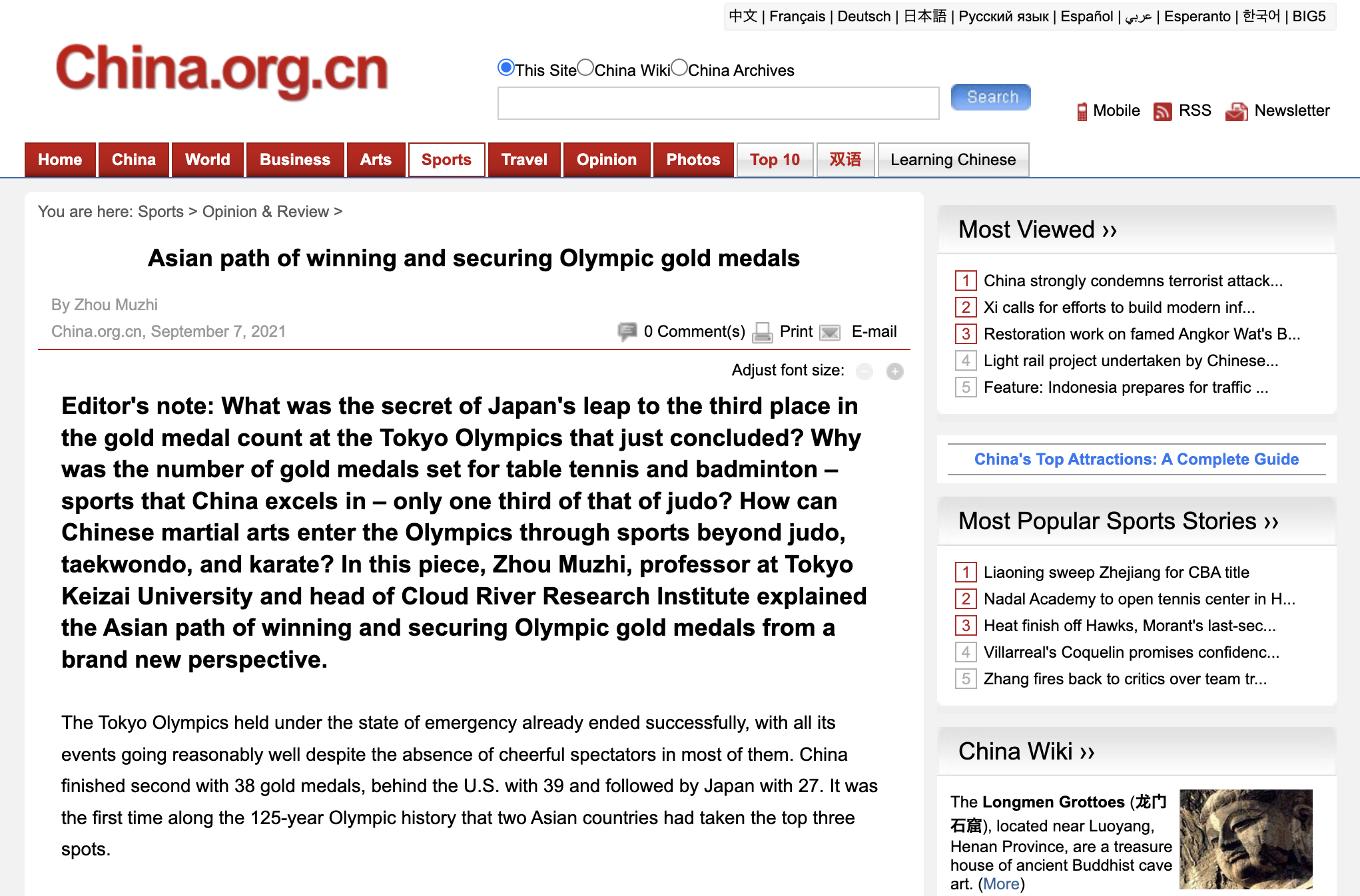Zhou Muzhi
Editor’s note:
What was the secret of Japan’s leap to the third place in the gold medal count at the Tokyo Olympics that just concluded? Why was the number of gold medals set for table tennis and badminton – sports that China excels in – only one third of that of judo? How can Chinese martial arts enter the Olympics through sports beyond judo, taekwondo, and karate? In this piece, Zhou Muzhi, professor at Tokyo Keizai University and head of Cloud River Research Institute explained the Asian path of winning and securing Olympic gold medals from a brand new perspective.
The Tokyo Olympics held under the state of emergency already ended successfully, with all its events going reasonably well despite the absence of cheerful spectators in most of them. China finished second with 38 gold medals, behind the U.S. with 39 and followed by Japan with 27. It was the first time along the 125-year Olympic history that two Asian countries had taken the top three spots.
1. New highlight of the Olympics: how to increase the gold medal tally?
Japan won 27 golds, 14 silvers and 17 bronzes at the Tokyo Olympics, 58 in total and setting its new record. Judo alone secured nine gold medals, the largest number of gold medals that the country won through a single sport, and a third of its total gold medals.
Japanese TV channels thus broadcast judo events live almost all day long during the Olympics, turning the diverse Olympics into an international judo competition.
Why is Japan so adept at judo? Why are there so many gold medals in it?
In fact, Japan promoted it to an Olympic sport at the 1964 Tokyo Olympics, with merely four gold medals. Through the efforts over more than half a century ever since, the sport has developed into a “big gold ore” with 15 gold medals.
In terms of the number of gold medals in the 33 sports of the Tokyo Olympics, judo ranks seventh, only behind track and field (47), swimming (34), gymnastics (18), wrestling (18), cycling (18), and kayak (16), and the same as weightlifting (15) and shooting (15). It is already a “big gold ore.”
The Japanese martial arts judo has been the hero of Japan’s Olympic gold medal tally. Especially at the 1992 Barcelona Olympics, the 1996 Atlanta Olympics, the 2000 Sydney Olympics, and the 2004 Athens Olympics, judo won two thirds, all, four fifths, and half of Japan’s gold medals, respectively, a matchless merit to its gold medal haul.
At the 13 Olympics with judo (no judo events at the 1968 Mexico City Olympics), Japan won 134 gold medals in total, of which judo took up 48 and ranked first. In other words, over a third of Japan’s gold medals at these Olympics came from judo events. In addition, Japan won up to 32% of the 152 Olympic gold medals in judo.
This Tokyo Olympics added five new sports – skateboarding, sport climbing, surfing, baseball and softball, and karate – with 18 gold medals, which also contributed significantly to Japan’s gold medal number. They added six gold, four silver, and four bronze medals to Japan’s medal table, which took up 22% of its golds, 29% of its silvers, and 24% of its bronzes. So to speak, the new sports gave an immediate boost to the medal tally.
Taking judo and volleyball added at the 1964 Tokyo Olympics into account, the seven sports added at two Tokyo Olympics contributed a total of 15 gold medals for Japan at the just-concluded Olympics, 55% of the country’s gold medal count.
Japan’s strategy of winning and securing gold medals – introducing and developing its “gold ore” sports – has yielded fruitful outcomes at this Tokyo Olympics.
2. Asian host countries vie for new events
The first Olympic Games held in Athens in 1896 had only nine sports: track and field, swimming, weightlifting, shooting, cycling, classical wrestling, gymnastics, fencing, and tennis. At the Tokyo 2020, there were 33 sports and 339 medal events. Over 他he past 125 years from the first Olympics to Tokyo 2020, many host counties have tried to strategically added events that they excel in.
There is a high bar set for adding new Olympic events, with many regulations and complicated review procedures entailed. The host country, however, has the authority to propose new events, although this authority varies in different periods.
The first opportunity for Asian countries came at the Tokyo 1964 Olympics. As the host country, Japan successfully introduced judo and volleyball to the Olympic arena as medal sports.
At the Tokyo 1964, Japan took three out of four golds in Judo, as well as one silver. In the competition for two gold medals in volleyball, the Japanese women’s volleyball team, dubbed the “Oriental Witch,” won the championship, and the men’s volleyball team won the bronze medal. At the Games, Japan harvested 16 gold medals, with judo and volleyball contributing a quarter.
The second chance was the Seoul 1988 Olympics. At this year’s Games, table tennis was added as a new sport. At the same time, badminton and Taekwondo made their Olympic debut as exhibition events. South Korea took two gold medals in table tennis that year. Badminton and Taekwondo also became big contributors to South Korea’s gold medal haul after they became formal medal events in the Barcelona Olympics in 1992 and the Sydney Olympics in 2000, respectively. Table tennis, badminton and Taekwondo have brought a combined 21 golds, 13 silvers, and 26 bronzes to South Korea.
Unfortunately, the Beijing 2008 Olympics failed to introduce new events, missing out an opportunity to add events in China’s favor.
Thanks to the experience gained at the Tokyo 1964 and after more than half a century of preparation, this year’s Tokyo Olympics added five new major events at a time, paving its road to gold medals.
3. China’s ‘gold ore’: Strong but not big enough
The 10 major events newly added to the Tokyo and Seoul Olympics (including those events that were added as exhibition events before becoming official medal events) — judo, volleyball, table tennis, badminton, taekwondo, skateboarding, rock climbing, surfing, baseball, and softball and karate, are mostly suitable for Asian athletes. These events have been big contributors to China’s gold medal tally. At the Tokyo 2020, China won six golds, eight silvers, and two bronzes at these events.
Especially in table tennis and badminton, China bagged four gold medals and two gold medals, respectively, accounting for four fifths and two fifths of the total in these two major events.
In previous Olympic Games, China won 32 gold medals in table tennis, accounting for 86% of the total in this major event. In badminton, China won 20 gold medals, accounting for 51% of the total. With its dominance in these two sports, China has already turned table tennis and badminton into its “gold ores.”
However, these two sports are not big enough in terms of gold medal numbers. The number of gold medals in table tennis had stayed at four since the Seoul Olympics, and was increased to only five at the Tokyo 2020.
Badminton has become an official event since the 1992 Barcelona Olympics, awarding four gold medals. The 1996 Atlanta Olympics increased the number to five, and yet the number remained unchanged ever since.
Table tennis and badminton failed to expand their gold medals as judo, which increased the originally four gold medals to 15.
Even so, among China’s gold medal haul in previous Games, table tennis ranks fourth after swimming (including diving), weightlifting and gymnastics, and badminton ranks sixth.
How to transform dominance to more medals should become an important link in the Olympic gold medal strategy.
4. Efforts to bring Wushu into the Olympics
Bringing the Chinese martial arts, or Wushu, into the Olympics has long been a shared dream of the Chinese people. The desire has grown stronger since other Asia-originated sports like Judo, Taekwondo, and Karate secured their places as major medal sports in the Olympics.
Why does Wushu always fail to make its way into the Olympics?
It missed out the opportunity to be included in the Games during the Beijing 2008 and only made its debut in the Olympics as a demonstration sport event even as China hosted the Games, with its attempt to become a medal sport failed in the following Olympics.
Is the preparation not long enough? It took 13 years for Judo to be included into the Olympics in 1964 since the founding of the International Judo Federation in 1951; it took Taekwondo 27 years to be an Olympic sport in 2000 since the founding of the International Taekwon-Do Federation; and it took 50 years for Karate to be a medal sport in Tokyo 2020 since the International Karate Federation founded in 1970. In contrast, it was already 18 years at the Beijing 2008 and 30 years for Tokyo 2020 since the International Wushu Federation founded in 1990. In this sense, Wushu’s failed attempt to the Olympics can not be attributed entirely to the lack of time in preparation.
The problem might be in the strategy of its application.
The International Wushu Federation submitted an application for inclusion to the International Olympic Committee (IOC) in 2001 featuring the men’s events for Changquan, Nanquan, Daoshu and Gunshu, and women’s events for Changquan, Taijiquan, Jianshu and Qiangshu. This kind of settings with complicated categories and inconsistent rules can hardly be approved in the deliberation process.
In contrast, Judo’s Olympic inclusion followed a path of “start small, aim big.” Since 1882, Kano Jigoro has toned down the dangerous elements of Jujutsu and created a set of systematic techniques to transform the traditional martial arts into the modern Judo. After World War Ⅱ, Japan actively promoted Judo worldwide and improved the combat rules, making it a well-accepted competitive sport globally.
In 1964, Judo joined the Olympic family with only a 4-gold medal setup and then expanded the medal count by adding different weight categories and female representation. Nowadays, Judo not only helps Japan climb higher on the medal tally but also gives the country a soft power boost, demonstrating its profound history and culture.
Learning from the experience of Judo’s path into the Olympics, the International Wushu Federation might as well abandon its all-inclusive practice and introduce a few most popular events to start with in its IOC application, before expanding more categories as an Olympic sport.
Taijiquan, with hundreds of millions of global followers, enjoys the highest popularity worldwide and should be the first choice in the IOC application. To introduce Taijiquan into the Olympics, we suggest the following three steps:
First, unify different schools of traditional Taijiquan into an internationally accepted sport with competition and performance features, and promote it worldwide. Second, establish the International Taijiquan Federation and push for its recognition by the Global Association of International Sports Federations and the IOC. Third, submit applications to the IOC to include Taijiquan an Olympic sport and add more categories into the sport afterwards.
To sump up, it needs the right strategy and long-standing efforts to promote China’s traditional culture into the Olympics and expand it into a major medal sport.
Dr. Zhen Xuehua, a senior researcher at Cloud River Urban Research Institute, has contributed to this article.
The article was published on China net on Sep 7, 2021, and was republished by foreign media.

